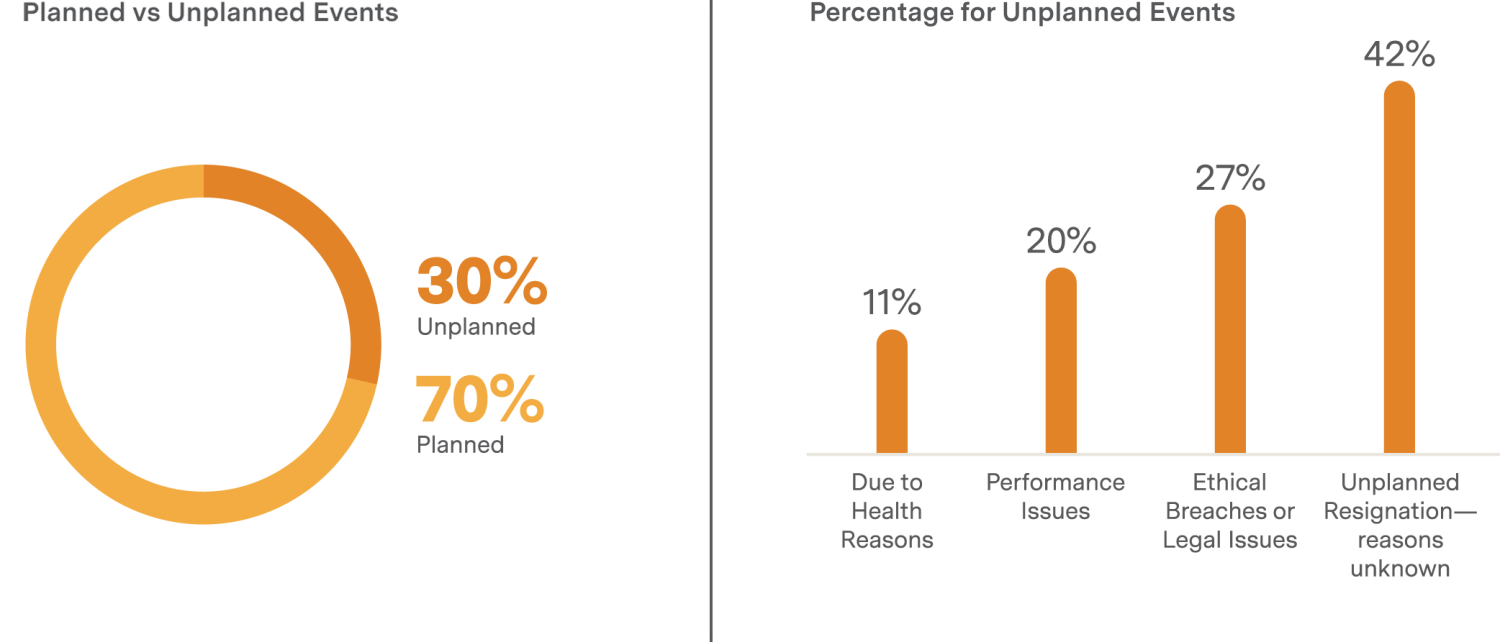Implementing succession planning best practices is vital for any organization aiming to secure its future leadership and operational stability. After all, Egon Zehnder found that nearly 1 in 3 CEOs is likely to exit their role with little notice, potentially leaving boards without a contingency plan. These unexpected departures can happen for several reasons, and may leave boards unprepared and scrambling for a new successor.
The strategic succession planning process is essential regardless of size or industry, as businesses must be prepared for leadership transitions to avoid potential disruptions and financial instability. Proper succession planning not only ensures continuity and preserves institutional knowledge but also maintains shareholder confidence—key components for long-term success. Conversely, the failure to plan adequately can lead to significant organizational upheaval and undermine a company's strategic objectives.
We spoke to three of our consultants who have handled successions with dozens of corporations all over the world, and learned from them about their experiences in the field.
Before we dive into their learnings, let’s level-set on what we’re referring to when we say “succession planning” and what this process means for your business’s future.
What is Succession Planning?
Succession planning is the process of identifying and developing future leaders at your company. The process involves evaluating and preparing potential successors for current and future needs, ensuring that the business continues to operate efficiently without interruption when key positions are vacated.
Succession planning is often viewed through the lens of C-suite transitions, but it should be a priority at every level of an organization to ensure a steady pipeline of leadership talent. Given the natural cycles of leadership, an effective CEO tenure is typically no more than two major strategic cycles—approximately eight years—after which a transition can be beneficial. This means organizations have, at most, eight years to develop top talent and prepare them for succession. A structured succession planning process, combined with regular development check-ins, is essential to ensure that high-potential executives are progressing toward a "ready now for promotion" status when leadership transitions arise.
What Are the Elements of a Succession Plan?
Developing a robust succession plan is crucial for the continuity and stability of leadership within any organization. Here are the essential components that should be included in an effective succession plan:
Leadership Assessment
Leadership assessments should be conducted regularly in a structured and continuous manner to evaluate the competencies, performance, and potential of both current leaders and rising talent. Beyond individual evaluations, these assessments provide a broader view of the succession pipeline, helping to identify potential gaps or biases in experience and competencies at an organizational level. This insight allows leadership teams to make informed adjustments to succession planning and talent management strategies, ensuring a strong and well-prepared leadership bench across the organization.
Development Efforts
Implement tailored, on-the-job development initiatives that provide potential successors with hands-on leadership experience. Rather than relying solely on technical training programs, organizations should focus on real-world leadership opportunities, such as strategic project assignments, cross-functional exposure, and executive mentoring. These experiential learning opportunities help future leaders develop both strategic acumen and leadership capabilities in a way that is directly applicable to their roles.
Career Pathing
Establish clear career paths that provide potential leaders with a visible trajectory for advancement within the organization. This not only helps in retaining top talent but also ensures that individuals are prepared and motivated to take on critical roles.
Succession Depth Chart
Create a visual representation or a detailed chart that outlines who is next in line for key roles within the organization. This should include information on each candidate’s readiness and timeline for potential promotion.
Communication Strategy
Develop a comprehensive communication plan that keeps all stakeholders informed about the succession planning process. This should include regular updates to ensure that the board, management, and other key personnel are aligned and engaged.
Strategic Alignment
Ensure that the succession plan is closely aligned with the company's long-term goals and strategic direction. This alignment helps to guarantee that future leaders are not only capable of sustaining current success but are also prepared to drive the organization forward in response to industry changes and challenges.
Board Support
The quality of a succession process is only as strong as the board overseeing it. A high-performing board ensures succession planning is a strategic, forward-thinking initiative rather than a reactive necessity. Board composition, diversity, and dynamics play a critical role in selecting future leaders, balancing continuity with innovation. A well-composed board fosters open dialogue, objective evaluation, and long-term alignment between leadership and business strategy. When boards are engaged, strategic, and cohesive, they elevate succession planning from a procedural task to a transformative process that secures the organization’s future.
Need support in implementing your executive succession planning process?
For those looking to implement these elements effectively, Egon Zehnder offers a detailed Executive Succession Planning Template. This downloadable resource provides a structured framework to help you evaluate potential leadership candidates across key dimensions crucial for success in executive roles.
To get a flavor of what to expect in this downloadable, you’ll have criteria to gauge succession readiness. The template covers competencies, potential, cultural fit, and more.
Building Agility into the Succession Planning Process
While structure and strategic planning are essential for effective leadership succession, adaptability is equally critical. Succession planning should never be a rigid, one-size-fits-all process. The reality is that leadership needs to evolve, business priorities shift, and unexpected events—such as market disruptions or sudden departures—can necessitate rapid adjustments. Organizations that take a flexible, dynamic approach to succession planning are better equipped to respond to these changes without compromising continuity or long-term strategy.
Agility in succession planning means regularly reassessing leadership pipelines, staying open to both internal and external talent, and ensuring that succession decisions align with real-time business needs rather than static timelines. It also requires fostering a culture of continuous leadership development rather than treating succession as an isolated event. By balancing structured planning with adaptability, organizations can build a resilient leadership pipeline that remains responsive to both opportunities and challenges.
21 Succession Planning Best Practices
If you’re on board with the importance of succession planning, but not sure where to start, we have some succession planning best practices to share with you that will help.
Let’s discuss the 21 best practices we learned from our consultants, Michael Meier, Elke Hofmann, and Caitlin Hughes.
1. Start Succession Planning Early
Starting early is crucial because it allows sufficient time for identifying potential external successors or developing internal talent. Early planning prevents rushed decisions and ensures smoother transitions.
The key to successful succession planning is starting early, particularly for large, publicly listed companies, where foresight can span several years.
Elke HoffmanHead of Egon Zehnder’s Munich office and co-leader of the CEO & Board Advisory Practice in Germany
2. Engage Your Board of Directors
Active board involvement ensures that succession planning aligns with the strategic direction and governance of the organization. It also secures necessary resources and support for the plan's execution.
Engaging the board in regular succession planning discussions ensures accountability and strategic alignment from the top down.
Michael MeierCo-head of Egon Zehnder’s global Family Business Advisory
3. Assess Current Leadership Gaps
Identifying gaps in leadership capabilities allows organizations to tailor development programs effectively or identify outside leaders who may possess the talents that fill these holes. By doing so, you ensure that potential leaders can meet future challenges.
Understanding current leadership gaps is essential for shaping a responsive succession strategy that addresses both immediate and future needs.
Caitlin HughesConsultant for Egon Zehnder’s Digital, Media and Technology, and Board practices
After you’ve identified these gaps, you’ll want to…
4. Foster Leadership Growth Through On-the-Job Development
The most effective leadership development comes from real-world experience rather than formal training programs. Organizations should focus on providing high-potential leaders with hands-on opportunities to expand their skills—whether through stretch assignments, cross-functional projects, or exposure to strategic decision-making. These experiences not only accelerate leadership readiness but also increase engagement and retention by offering meaningful career growth.
Developing internal talent through structured leadership programs prepares individuals for future roles, enhancing both capability and confidence.
Elke HoffmanHead of Egon Zehnder’s Munich office and co-leader of the CEO & Board Advisory Practice in Germany
5. Align Succession Plans with Business Strategy
Alignment with the business strategy ensures that the leadership pipeline supports the organization’s long-term objectives, fostering growth and stability.
Succession planning must be a strategic extension of the company’s long-term goals, ensuring future leaders can carry forward the vision.
Michael MeierCo-head of Egon Zehnder’s global Family Business Advisory
6. Diversify Your Leadership Pipeline
Diversity in leadership brings different perspectives and ideas, which can drive innovation and reflect the demographic diversity of the market and workforce.
Integrating diversity into the leadership pipeline enriches decision making and mirrors the broader market and society – but diversity encompasses much more than gender and race. It’s important to consider candidates across the spectrum of capabilities, ways of thinking, and experiences. By looking at a diverse range of candidates, you could uncover a successor that no one expected, but who will do great things for your organization’s future.
Michael MeierCo-head of Egon Zehnder’s global Family Business Advisory
7. Conduct Regular Talent Reviews
Schedule reviews consistently to keep track of the development progress of potential successors and help in making proactive adjustments to the succession plan as needed.
Regular talent reviews help in tracking the development progress of potential leaders and making informed decisions about succession. This process also helps to identify gaps that potential successors may have, and develop their skills over the years to come so they may fill a vacancy down the line.
Caitlin HughesConsultant for Egon Zehnder’s Digital, Media and Technology, and Board practices
8. Create Cross-Functional Opportunities
Exposure to different parts of the business helps potential leaders understand the organization comprehensively, enhancing their ability to make informed strategic decisions.
Exposing potential leaders – such as the CFO participating in CEO decision making processes – allows for better cross-functional role development and greater understanding of the business at a holistic level.
Elke HoffmanHead of Egon Zehnder’s Munich office and co-leader of the CEO & Board Advisory Practice in Germany

CFO Succession Planning: The Complete Guide from Egon Zehnder
As your organization is faced with a CFO changeover, the need for thoughtful and strategic CFO succession planning is a must. Learn more about…
9. Establish Clear Metrics for Success
Clear metrics enable the organization to measure the effectiveness of the succession planning process and make data-driven improvements. The Board should be driving this conversation, determining the criteria for which a potential successor will be evaluated against.
Setting clear, measurable outcomes for your potential successors, as well as the succession initiative as a whole, ensures that they are achieving intended goals and contributing to organizational health.
Elke HoffmanHead of Egon Zehnder’s Munich office and co-leader of the CEO & Board Advisory Practice in Germany

Executive Succession Planning Template & Guidance
When it comes to executive succession, having support is key. Utilize our succession planning template as a first step, and seek help if you…
10. Plan to Adapt Your Plan
Flexibility in the succession plan allows the organization to adapt to unexpected changes in leadership needs without significant disruptions. The ability to be nimble and adapt as you go through the process will lead to a better outcome and ensure you put the right people in the right roles when the time for that succession comes.
Flexibility in succession planning allows for adjustments as business needs evolve and new challenges emerge.
Michael MeierCo-head of the Egon Zehnder’s global Family Business Advisory
11. Make Use of HR Data and Analytics
Data and analytics provide insights into the performance and potential of leaders, supporting more informed and objective decision-making in the succession process.
Leveraging HR data and analytics provides a data-driven foundation for decision-making in succession planning. For example, your company’s HR platform could be used to evaluate capabilities and competencies of potential internal successors, and track their development over time.
Caitlin HughesConsultant for Egon Zehnder’s Digital, Media and Technology, and Board practices
12. Address Potential Legal Implications
Considering the legal aspects ensures that the succession planning process complies with all relevant laws and regulations, minimizing risk. For example, perhaps a potential external successor is in a binding contract for a certain period of time – it’s important to have the full lay of the land and understand any legal implications of decisions before moving forward.
13. Plan for Both Planned and Unplanned Transitions
Preparing for both scenarios ensures that the organization remains stable and capable of effective leadership continuity under any circumstances.

Preparing for both planned and sudden leadership changes ensures the organization remains resilient and capable of smooth transitions. Conversely, only planning for best case scenarios could leave your Board and organization in a very tough place.
Elke HoffmanHead of Egon Zehnder’s Munich office and co-leader of the CEO & Board Advisory Practice in Germany
14. Foster Open Communication
Transparency in the process builds trust within the organization, reduces resistance to change, and ensures that all stakeholders are aligned and supportive, including the CEO.
Open communication about succession plans reduces anxiety and resistance, fostering a culture of transparency and inclusion. This shouldn’t be something that the Board speaks about in hush hush conversations, but rather an open process that involves the CEO from day one of their tenure, to the Board and CEO are always prepared for unexpected changes in leadership needs.
Caitlin HughesConsultant for Egon Zehnder’s Digital, Media and Technology, and Board practices.
15. Consider the Unique Dynamic of Family-Owned Businesses
Tailoring succession strategies to the unique dynamics of family-owned businesses helps preserve family legacy while driving future growth – and it’s highly recommended to have a family business advisory mechanism when making decisions to preserve family relationships and long-term business success. This is also key for nurturing the specific family business culture.
Family-owned businesses require tailored succession approaches that respect familial relationships and other family-owned assets, while prioritizing the business's future needs. This balance is more nuanced when considering deep family relationships and how those play out in a business setting.
Michael MeierCo-head of the Egon Zehnder’s global Family Business Advisory

The Benefits of Keeping Your Family in the Family Business
Curious what the benefits are for keeping your family involved in your family-owned business? There are many! Learn from our consulting experience.
16. Implement Peer Mentoring Programs
Peer mentoring enriches the developmental process, offering potential leaders insights and learning from experienced colleagues. This is especially critical for leaders who are in consideration for new roles in the future. Allow them to learn from the people they’ll be succeeding one day so they’re prepared when that day comes.
Peer mentoring supports leadership development by sharing knowledge and experiences, crucial for preparing successors for the day they take on that new role.
Caitlin HughesConsultant for Egon Zehnder’s Digital, Media and Technology, and Board practices
17. Consider Succession Planning for Non-Leadership Roles
As mentioned earlier, the C-suite is typically the primary focus for succession planning – but the truth is that extending succession planning to include non-leadership roles ensures all critical functions are covered, maintaining operational continuity.
Succession planning should also encompass critical non-leadership roles to ensure all areas of the business are prepared for future changes. Think about it – if you have someone in an executive role step in for a CEO who is leaving, that will have a cascading effect throughout your organization, showing the importance of succession planning at all levels. It’s critical to think organization-wide in this planning process.
Michael MeierCo-head of the Egon Zehnder’s global Family Business Advisory
18. Stay Ahead of Industry Shifts and Market Dynamics
Staying informed about industry trends is not just beneficial—it’s essential. The pace of technological advancement, shifting market demands, and economic uncertainty require leaders who can navigate complexity with agility and foresight. Rather than simply understanding current industry conditions, leadership teams must anticipate disruptions, adapt strategies proactively, and position the organization for long-term resilience.
A strong succession pipeline should prioritize leaders who are not only well-versed in their industry but also capable of embracing change, thinking innovatively, and making decisions in ambiguous or volatile environments. Ensuring future leaders have the ability to pivot, experiment, and respond effectively to market shifts will help safeguard the business against unforeseen challenges and ensure sustained success.
Staying informed about industry trends ensures that succession plans align with current and future market conditions – we can’t stress enough how important adaptability and curiosity are in this process. Your future leader should possess both.
Caitlin HughesConsultant for Egon Zehnder’s Digital, Media and Technology, and Board practices
19. Go External to Fill Gaps
In most instances, nurturing succession talent internally is preferable – but sometimes, if the right successor isn’t coming to fruition, bringing in external talent can introduce new skills and perspectives. In turn, this could enrich your talent pool and help move your organization forward.
External recruitment can be necessary to bring in fresh perspectives or specific skills that are not currently available within the organization. This should be done with the utmost care, and as much pre-planning as possible to ensure that an external successor will be the right fit for your business and culture.
Michael MeierCo-head of the Egon Zehnder’s global Family Business Advisory
20. Start Early, Dig Deep
Effective CEO succession planning requires more than timely decisions – it demands an early start and deep integration into the organization's fabric. By beginning the succession process early, boards can systematically develop and evaluate potential leaders throughout their careers, ensuring a ready pool of capable candidates well before the need arises.
The best successions are those that start early and go beyond superficial evaluations to truly understand and develop the depth of leadership talent. This approach a) prepares candidates for the unique challenges ahead and b) aligns their growth with the strategic needs of the organization.
Elke HoffmanHead of Egon Zehnder’s Munich office and co-leader of the CEO & Board Advisory Practice in Germany
21. Utilize the Unbiased View of External Consultants
External consultants provide objective assessments and fresh insights, which can help overcome internal biases and bring best practices to the succession planning process.
External consultants – like all of us at Egon Zehnder – offer an unbiased perspective, essential for ensuring the integrity and effectiveness of the succession planning process. We’ll help you look at candidates with an objective viewpoint, ensuring that your biases are not coming through in your decision. We'll also act as collaborative partners to bounce ideas off of as you go through this crucial planning process.
Caitlin HughesConsultant for Egon Zehnder’s Digital, Media and Technology, and Board practices
Finding the Right Succession Planning Partner
Partnering with a third-party consultant, like Egon Zehnder, provides specialized expertise in developing and executing effective succession plans. Beyond structuring a seamless transition process, an external advisor brings an objective perspective—helping organizations assess internal talent against market benchmarks to ensure they are developing leaders who can compete at the highest level. This comparative insight is invaluable in refining leadership development strategies and making informed succession decisions.
Need support with planning the future of your organization’s leadership? Get in touch with our team today to learn about our unique approach to implementing succession planning best practices.





